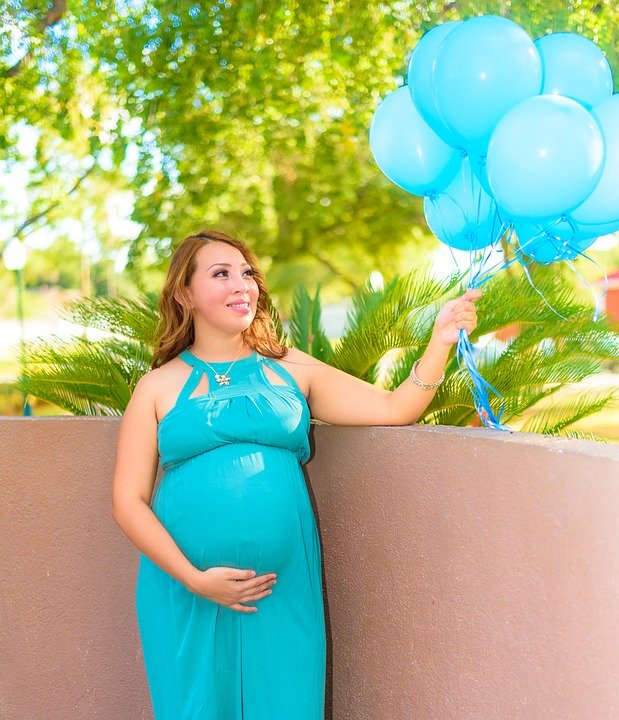‘A window has been opened’

Pregnancy Summer Pregnant Women Nature
BOZEMAN — Mindy Misener said she’s always been supportive of her friends who have delivered babies at home under the guidance of a midwife, but it wasn’t something she envisioned for herself. She had been planning to give birth in a hospital and sought care from a provider at Bozeman Health early in her pregnancy. Then COVID-19 hit and she started considering alternatives to a hospital birth.
“There were stories, especially out of New York, of women being asked to labor [in hospitals] alone. … It sounded scary [and] upsetting, and it’s something I thought I would only do if I really had to,” Misener said.
In late March, she set up a consultation with a midwife who came highly recommended. After meeting with the midwife and doing research, giving birth at home shifted from something Misener hadn’t seriously considered to her preferred option.
“I like the privacy and comfort of my own home and [that it’s] more of a closed system of who’s involved, how they’re involved, and what they’re asked to do,” Misener said. She added that she appreciates the relationship she’s developed with her midwife and how much she’s learned in the past two months about childbirth — including the fact that it can be done safely at home.
A study in The Lancet bears this out. Researchers comparing data from 14 studies determined that maternal and neonatal mortality is no greater in home birth settings, so long as attending midwives were well integrated into health services.
Giving birth at home will preclude Misener from certain procedures that are common in hospitals — she won’t be able to get an epidural to manage pain or take pitocin to induce or accelerate labor, for example — but she and her husband have been learning other techniques to facilitate the experience she wants.
“[With a home birth], you don’t just hand yourself over to medical professionals and have them carry you through,” she said. “I have really engaged with the process more.”
Misener, who’s due July 9, had enough time to comfortably change her plans from a hospital birth to a home birth, but that isn’t the case for some pregnant women. Bozeman-based midwife Jazmin Hieronymus has recently been fielding calls from expecting women in Gallatin Valley who are due in as little as two weeks. In the consultations she’s given — which are on the rise, she notes — she’s finding that many potential clients aren’t able to transition to a home birth, even if they’d like to.
“The biggest hang-up is not a fear of home birth,” she said. “The hang-up is the financial piece.” Home birth may not have been on her potential clients’ radar pre-pandemic, she said, and now it presents as an unplanned expense — 90% her clients are cash-pay — at a time when many families are already struggling to pay their bills.
Nationally, 43% of pregnancies are financed by Medicaid, and whether or not Medicaid will cover out-of-hospital births varies widely by state, according to the Kaiser Family Foundation, which surveyed 40 states and the District of Columbia in its examination of Medicaid benefits available to pregnant women and new mothers. Medicaid covered birth centers for 78% of the survey’s respondents; about half of them covered home birth.
In Montana, birth centers are eligible for Medicaid coverage, but home births are not, despite the fact that Montana has the highest home birth rate (2.74%) in the nation.
According to the Department of Labor and Industry, there are currently 31 licensed direct-entry midwives and nine midwife apprentices in Montana. (Direct-entry midwives obtain training through an accredited midwifery school, whereas certified nurse-midwives have a nursing degree.)
During the 2019 legislative session, Hieronymus advocated for House Bill 248, which would have required Medicaid to cover low-risk home births attended by a licensed direct-entry midwife. (Women who have a history of pregnancy complications, are older than 35, are carrying multiple fetuses, or exhibit certain medical conditions like high blood pressure or diabetes are generally considered high risk and unsuited for home delivery.) The bill died after being tabled by the House’s Human Services Committee.
“It’s unfortunate, because had that gone through, it would have made the conversations I’m having with the families I’m working with now so much easier,” Hieronymus said, adding that she hopes the measure is resurrected in the 2021 session.
The vast majority of Americans who are eligible for an out-of-hospital birth have opted not to go that route in recent decades. Just 1.6% of all U.S. births take place at home or in a birth center, even though approximately 80% of the country’s pregnant women are eligible to. But that’s changing, and freestanding birth centers, facilities based on a midwifery and maternal wellness model that generally provide more “homey” places to give birth, play a prominent role in that shift.
BOOMING BIRTH CENTERS
According to Kate Bauer, executive director of the American Association of Birth Centers, the number of birth centers in the U.S. has grown by 200% in the past decade — and she said COVID-19 could accelerate that trend. Bauer said her organization’s members have been seeing an increase in patient registrations and late transfers since COVID-19 upended America’s health care system.
“More people are exploring their options for maternity care,” Bauer said. “A window has been opened.”
Kayla Wright, a nurse midwife and women’s health nurse practitioner, said she’s had to cap new client admissions for the first time in the Bozeman Birth Center’s history. All 14 available spots for July are full, even after she hired a second midwife to work through the summer.
Some of Wright’s clients are concerned about COVID-19 infection risk at Bozeman’s sole hospital, while others are drawn to her practice because they’re looking for more flexible policies than those offered by the hospital, she said. (Under Bozeman Health’s current policy, pregnant women are allowed just one support person throughout their delivery and postpartum care, and their access to in-person lactation support is limited to their initial hospital stay. Melissa Wolf, an OB-GYN who’s serving as a medical technical specialist on Bozeman Health’s COVID-19 incident command team, said her colleagues understand and appreciate that their patients are accustomed to having more people present at their births and are constantly evaluating their policies.)
Wright is optimistic that the pandemic will encourage women to reconsider options like birth centers — or at least gain a broader awareness of what’s available.
“It’s always been the case that hospitals are for sick people and pregnant women and their babies are the only healthy people in a hospital,” she said. “[Now] people are reconsidering going to a hospital if they aren’t sick.”
RETHINKING THE ‘MEDICALIZATION’ OF BIRTH
International maternal and infant health strategist Kimberly Seals Allers said one of COVID-19’s silver linings is that it’s creating space for systemic change. “I think this moment of looking outside ourselves as a country is great for birth and breastfeeding,” she said. “There are other models out there.”
In the Netherlands, for example, the home birth rate is 20% and the maternal mortality rate is one-quarter of the United States’; New Zealand has twice the rate of home births as the United States and about half as many maternal deaths per 100,000 births.
For decades, Americans have been led to believe that the hospital is the only safe place to deliver a baby, Seals Allers said. As a result, home birth rates fell — and fell, and fell – throughout the 20th century, from an estimated 99% of deliveries in 1900 to less than 2% today.
“The whole medical system took over, and they were very successful in telling us that hospitals were safe and anything else was not,” Seals Allers said.
As with so many aspects of health care, COVID-19 is disrupting that narrative and creating space for other approaches. Seals Allers said that historically, pandemics and periods of social unrest like the Spanish Flu and the Great Depression have seeded significant societal change. She said she’s hopeful this pandemic will foster a “new appreciation for the roles of women writ large” and a reframing of childbirth.
“Birth is not a medical event,” Seals Allers said. “We don’t have to be in a hospital to give birth. The idea of a child birth center should not be strange — it should be the norm.”
A 2018 recommendation issued by the World Health Organization echoes some of Seals Allers concerns. “We want women to give birth in a safe environment with skilled birth attendants in well-equipped facilities. However, the increasing medicalization of normal childbirth processes are undermining a woman’s own capability to give birth and negatively impacting her birth experience,” said South Africa’s Princess Nothemba Simelela, an obstetrician and WHO’s assistant director-general for family, women, children and adolescents.
“Childbirth is a normal physiological process that can be accomplished without complications for the majority of women and babies,” the statement continues. “However, studies show a substantial proportion of healthy pregnant women undergo at least one clinical intervention during [labor] and birth. They are also often subjected to needless and potentially harmful routine interventions.”
In the United States, one of the most common interventions is delivery via caesarean section, which occurs in 32% of U.S. births, among the highest rates in developed countries. The World Health Organization notes that the procedure can be life-saving for mothers and infants, but it is often not medically indicated and can result in short- and long-term risks for the mother, her child, and future pregnancies.
When American women give birth outside of hospitals, they undergo significantly fewer interventions like caesarean sections and generally report a more positive experience. There is, however, an increased risk of adverse outcomes for their babies. An opinion issued by the American College of Obstetricians and Gynecologists notes that planned home birth is associated with a more than twofold increased risk of perinatal death (1-2 per 1,000 infants) and a threefold increased risk of neonatal seizures or serious neurologic dysfunction (0.4–0.6 per 1,000 infants). Researchers have found that neonatal outcomes are comparable to hospital births in other developed countries including the Netherlands, Australia and the U.K., perhaps due to cooperative relationships between midwives and hospitals if a transfer is required, and established guidelines about who’s eligible for a home birth.
Both Hieronymus and Wright said pregnant women should go with what feels right for them. “If people transfer into the Birth Center, I still make sure it’s because they want to birth in the Birth Center, not because they’re scared of the hospital. Decisions made in fear rarely end in a happy, empowered place,” Wright said.
For her part, Misener is grateful that she has a low-risk pregnancy, and that women have options — including birthing at a hospital. She said she had a positive experience with the provider she was seeing at Bozeman Health. “There’s nothing that made us run from the hospital,” she said. “[My husband and I] just didn’t see the point in going back. … A home birth is the better choice for me.”
The Article was originally published on ‘A window has been opened’.







